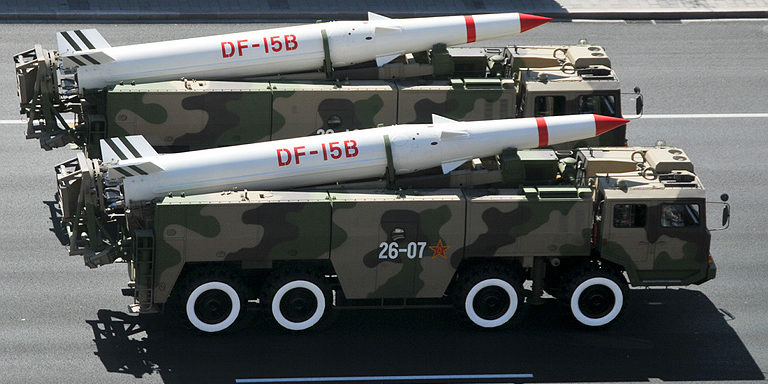Facts
| China/U.S. Designation | Dong Feng-15 (DF-15/M-9)/CSS-6 |
| Missile Variants | DF-15A/DF-15B/DF-15C/Shaheen |
| Mobility and Role | Road mobile, short-range surface-to-surface ballistic missiles |
| Designer/Producer | People’s Republic of China |
| Range | 600-800km[i] |
| Warhead Type and Weight | HE, nuclear, chemical, sub-munitions/500-800kg[ii] |
| MIRV and Yield | No MIRV capabilities/50-350KT[iii] |
| Guidance System/Accuracy | Inertial (DF-15); GPS & Radar Terminal Correlation (DF-15A); Laser Range Finder (DF-15B)/300m CEP (DF-15); 30m CEP (DF-15A); 5-10m CEP (DF-15B) |
| Stages/Propellant | Single/Solid |
| IOC/Retirement | 1989/Still in service |
| Status/Number of Units | Operational/90-110 launchers; 350-400 missiles “est”[iv] |
Overview
Unveiled for the first time at the Beijing Defense Exposition in 1988, the DF-15 was developed in the late 1980’s and deemed operational in 1989. The single-stage, solid-fueled, SRBM is the first creation in the DF-15 family by the People’s Republic of China. With a range of 600-800km, the missile uses an inertial-based guidance system and has a CEP of 50-100m. Fired from the Transporter Erector Launcher, the DF-15 SRBM requires 30 minutes for launch preparation.[v] The DF-15 has been upgraded several times into more powerful variants like the DF-15A, DF-15B, and DF-15C. China is believed to manufacture between 30-50 DF-15s a year and as of 2010, the PRC possessed approximately 350-400 operational DF-15 SRBMs.[vi]
The DF-15A variant is fitted with a new missile focused on improving accuracy and range which became operational in 1996. The missile is slightly larger than the original DF-15 and has a range of 900km as well as a 100m CEP.[vii]
The DF-15B is an upgraded version of the DF-15A that significantly increased the missiles accuracy. The DF-15B also introduced a new TEL launcher. Revealed for the first time during a 2009 military parade in Beijing, this SRBM features superior GPS and terminal guidance systems and possesses an active radar seeker and laser rangefinder.[viii] The DF15-B has a range up to 800km, a 35-50 CEP, and a single 500kg conventional warhead.[ix]
The DF-15C, or Bunker Buster, was designed to strike underground facilities by hosting a deep-penetration warhead and is identified by its extended cylindrical nosecone.[x] The DF-14B and DF-15C are both two-stage modifications from their former variants however the DF-15C is specifically intended to attack hardened underground bunkers.[xi] Like most of the DF-15 family, the DF-15C is deployed in a vertical position by using TAS5450 or WS-2400 TEL launchers. As of 2017, the DF-15C has yet to be deemed operational.[xii]
Strategic Implications
The DF-15 family offers a variety of strategic implications for the People’s Republic of China. Tested heavily during the 1995/1996 Taiwan Strait Missile Crisis, it is apparent that the DF-15 missiles are often used as a deterrent from Taiwan seeking independence.[xiii] This is further noticeable by the DF-15C which is designed to attack underground military targets such as hardened military facilities located in Taiwan. According to one estimate by the RAND Corporation, the PRC’s DF-15 stockpile alone is nearly double the size needed to eliminate Taiwan’s attack aircraft infrastructure.[xiv] The extended range on the DF-15A allows China to expand their strike range beyond Taiwan, reaching as far as South Korea and parts of northern India.[xv] If relocated elsewhere along the PRC’s border, the DF-15B variant is capable of reaching Kadena Air Base, Japan to the east,[xvi] and New Delhi, India to the southwest.[xvii] Thus, the DF-15 remains a versatile component of the PRC’s rapid attack and anti-access/area denial capabilities.
Sources
[i] Eric Heginbotham, The U.S.-China Military Scorecard: Forces, Geography, and the Evolving Balance of Power, 1996-2017, RAND Corporation, 2015, pg. 47. http://www.rand.org/content/dam/rand/pubs/research_reports/RR300/RR392/RAND_RR392.pdf
[ii] Jane’s Intelligence Review, “Missile race heightens tension across the Taiwan Strait,” IHS, December 9, 2004, https://janes.ihs.com/Janes/Display/1195172; Center for Strategic and International Studies Missile Defense Project, “DF-15 (CSS-6),” last updated January 11, 2017, https://missilethreat.csis.org/missile/df-15-css-6/
[iii] Global Security , “DF-15 [CSS-6 / M-9],” no date, http://www.globalsecurity.org/wmd/world/china/df-15.htm
[iv] Office of the Secretary of Defense, Military and Security Developments Involving the
People’s Republic of China, 2010, p. 66, https://www.defense.gov/Portals/1/Documents/pubs/2010_CMPR_Final.pdf
[v] Ibid.
[vi] Office of the Secretary of Defense, Military and Security Developments Involving the People’s Republic of China.
[vii] http://www.armyrecognition.com/china_chinese_army_missile_systems_vehicles/df-15_df-15a_css-6_short-range_ballistic_missile_technical_data_sheet_specifications_pictures_video_010502163.html
[viii] http://www.armyrecognition.com/china_chinese_army_missile_systems_vehicles/df-15b_short-range_ballistic_missile_technical_data_sheet_specifications_pictures_video_12002163.html
[ix] http://www.ausairpower.net/APA-PLA-Second-Artillery-Corps.html
[x] https://sinodefence.com/2016/12/03/df-15/
[xi] https://missilethreat.csis.org/missile/df-15-css-6/
[xii] https://tiananmenstremendousachievements.wordpress.com/2015/12/25/chinas-df-15c-bunker-busting-penetrator-better-than-us-gbu-57ab/
[xiii] http://www.deagel.com/Ballistic-Missiles/DF-15_a000856001.aspx
[xiv] Jane’s Intelligence Review, “Power posturing – China’s tactical nuclear stance comes of age,” IHS, August 12, 2010, https://janes.ihs.com/Janes/Display/1196044.
[xv] Heginbothan, The U.S.-China Military Scorecard, p. 47.
[xvi] Heginbothan, The U.S.-China Military Scorecard, p. 61.
[xvii] News Corp Australia, “China releases first photos of DF-15C ‘bunker buster’, short-range ballistic missile with deep-penetration warhead.”

